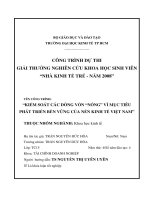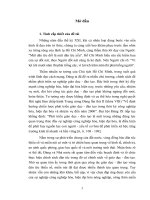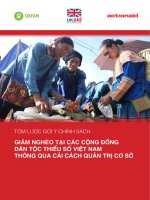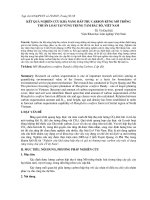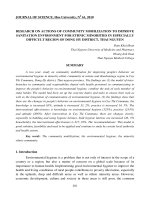nghiên cứu cùng cộng đồng ứng dụng nhân học trong phát triển ở vùng dân tộc thiểu số việt nam
Bạn đang xem bản rút gọn của tài liệu. Xem và tải ngay bản đầy đủ của tài liệu tại đây (4.55 MB, 185 trang )
0
HỘI THẢO
Nghiên cứu cùng cộng đồng: Ứng dụng nhân học trong phát triển ở
vùng dân tộc thiểu số Việt Nam
CONFERENCE
Co-research: Applying Anthropology
in Ethnic Minority Development in Vietnam
Hà Nội, 01/10/2014
1
CHƯƠNG TRÌNH HỘI THẢO DỰ KIẾN
Nghiên cu cùng cng: ng dng nhân hc trong phát trin vùng dân tc
thiu s Vit Nam
Thi gian: Ngày 01/10/2014
t chc: Vin Dân tc hc (Vin Hàn lâm Khoa hc Xã hi Vit Nam)
Vin Nghiên cu Xã hi, Kinh t ng (iSEE)
B môn Nhân hc - i hc Khoa hc Xã h
Thời gian
Nội dung
Người trình bày / phụ trách
m Qu
8:00 8:25
8:30 8:45
Khai mc
Vin Dân tc hc
8:45 9:05
Tip cn da vào c ng trong
nghiên cn dã nhân hc qua mt s
c hành
TS. Nguyng Giang
i hc Khoa hc Xã
h i hc
Quc gia Hà Ni
9:05 9:25
Tip cn vi ng hi ng hc
trong nghiên cu nhân hc
TS. Nguyc Lc
i hc Khoa hc Xã
h
i hc Quc gia Tp H Chí
Minh
9:25 10:00
Tho lun chung
TS. c, TS. Hoàng
Cm
i biu khác
10:00 10:20
Gii lao
10:20 10:40
Ting nói c i dân và nhng rào
cn trong n lng trách nhim
gii trình: Kinh nghim qua d
ng trách nhim gi
sóc sc kho sinh sn và k hoch hoá
vùng dân tc thiu s tnh
ng
ThS. Nguyn Thu Qunh
Vin Khoa Hc Xã Hi Vùng
Trung B, Vin Hàn lâm
Khoa hc Xã hi Vit Nam
10:40 11:10
V xây dng nim tin và chuyn
giao quyn lc trong nghiên cu cùng
cng: Nghiên cng hp ch
Mông Sa Pa và ch Ede Dak Lak
Nhóm nghiên cu cùng cng
ng
Vin Nghiên cu Xã hi,
Kinh t ng
2
11:10 11:50
Tho lun chung
PGS. TS. c, TS.
Hoàng Cm
i biu khác
11:50 13:20
Chiu hành: ThS. Nguyn Công Tho, TS. Phm Qu
13:30 13:50
Nghiên cu nhân hc v s bii xã
hi và quá trình phát trin mt xã dân
tc thiu s min Bc Vit Nam: Làm
th mt d án phát trin thích
ng vi bi c
TS. Christian Culas
CNRS Centre Norbert Elias,
Marseilles, France
13:50 14:10
Nhìn li các chính sách phát trin ti mt
làng ngh truyn th
cái nhìn t bên trong c
ThS. Qui Tuyên
Trung tâm Nghiên c
14:10 14:40
Tho lun chung
PGS. TS. Lâm Bá Nam
PGS. TS. Nguyn Th
i biu khác
14:40 15:00
Gii lao
15:00 15:20
S dng công c nghiên cng tham
gia (PRA) trong nghiên cu sc khe
sinh thái: Nghiên cng hp v cht
thi nông nghip và cht thi ca ngi
tnh Hà Nam
TS. Trn Minh Hng
Vin Dân tc hc
15:20 15:40
Nâng quyn cho c ng thiu s
trong xây dng rng cng: Tr li
nhng giá tr rng tâm linh truyn thng
ThS. H Vit Hoàng
Khoa Vit Nam hc,
i hc Ngoi ng Hu
15:40 16:15
Tho lun chung
PGS. TS. Lâm Bá Nam
PGS. TS. Nguyn Th
i biu khác
16:15 16:30
B mc
ThS. Lê Quang Bình
Vin Nghiên cu Xã hi,
Kinh t ng
3
CONFERENCE AGENDA
Co-research: Applying Anthropology
in Ethnic Minority Development in Vietnam
Date: 01/10/2014
Organizers: Institute of Anthropology (Vietnam Academy of Social Sciences)
Institute for Studies of Society, Economy and Environment
Department of Anthropology (University of Social Sciences and Humanities)
Time
Content
Presenter
Morning. Facilitators: Assoc. Prof. Dr. m Qu
8:00 8:25
Registration
8:30 8:45
Opening speech
Assoc. Prof
Tình
Institute of Anthropology
Vietnam Academy of Social
Sciences
8:45 9:05
Community-based approach in
anthropological research and
fieldwork:Some methods and practices
Dr. Nguyng Giang
University of Social Sciences
and Humanities, Vietnam
National University Hanoi
9:05 9:25
Phenomenological Approaches in
Anthropology
Dr. Nguyc Lc
University of Social Sciences
and Humanities, Vietnam
National University Ho Chi
Minh City
9:25 10:00
General discussion
Dr. c,
Dr. Hoàng Cm
and other participants
10:00 10:20
Teabreak
10:20 10:40
improving accountability: Experiences
of a project to improve the
accountability of reproductive health
and family planning services in ethnic
minority localities of Lam Dong
province.
Nguyn Thu Qunh, MA.
Institute of Social Sciences of
the Central Region, Vietnam
Academy of Social Sciences
4
10:40 11:10
Trust building and power shift in co-
research: Case studies of Hmong script
in Sa Pa and Ede script in Dak Lak
Co-research team
Institute for Studies of Society,
Economy and Environment
11:10 11:50
General discussion
Dr. c,
Dr. Hoàng Cm
and other participants
11:50 13:20
Lunch
All participants
Afternoon. Facilitators: Nguyn Công Tho, MA. and Dr. Phm Qu
13:30 13:50
Anthropological research about social
changes and development process in
ethnic commune of Northern Vietnam:
How to adapt a development project to
local context?
Dr. Christian Culas
CNRS Centre Norbert Elias,
Marseilles, France
13:50 14:10
Implementing development projects at
a Cham handicraft village, Ninhthuan
province: A view from Cham
indigenous community
Qui Tuyên, MA.
Center for Cham Culture
Studies
14:10 14:40
General discussion
Assoc. Prof. Dr. Lâm Bá Nam
Assoc. Prof. Dr. Nguyn Th
and other participants
14:40 15:00
Teabreak
15:00 15:20
Applying participatory rural appraisal
(PRA) tools in ecological health
research: A case study of agricultural
and human waste in Ha Nam province
Dr. Trn Minh Hng
Institute of Anthropology
15:20 15:40
Empowering ethnic minority
communities in community forestry:
Going back to the traditional spiritual
forest values
H Vit Hoàng, MA.
Department of Vietnamese
Studies,
Hue University College of
Foreign Languages
15:40 16:15
General discussion
Assoc. Prof. Dr. Lâm Bá Nam
Assoc. Prof. Dr. Nguyn Th
and other participants
16:15 16:30
Closing remark
Lê Quang Bình, MPP.
Institute for Studies of Society,
Economy and Environment
5
MỤC LỤC
1. ANTHROPOLOGICAL RESEARCH ON SOCIAL CHANGES AND THE
DEVELOPMENT PROCESS IN AN ETHNIC COMMUNE OF NORTHERN
VIETNAM: HOW IS A DEVELOPMENT PROJECT TO BE ADAPTED TO THE
LOCAL CONTEXT? 7
Dr. Christian CULAS and Dr. Emmanuel PANNIER
2. TIP CN DA VÀO CNG TRONG NGHIÊN C N DÃ NHÂN
HC QUA MT S C HÀNH 17
TS. Nguyễn Trường Giang
3. U TRA TÔN GIÁO HCTRONG NHÂN HC TÔN GIÁO 33
TS. Lê Đức Hạnh
4. NÂNG QUYN CHO C NG THIU S TRONG XÂY DNG RNG
CNG: TR LI NHNG GIÁ TR RNG TÂM LINH TRUYN THNG 44
NCS. Hồ Viết Hoàng
5. CÁC PHÁP NGHIÊN CNG THAM GIA VÀ NG DNG VÀO
LP K HOCH CHU TRÌNH D ÁN GI NG BÀO DÂN
TC THIU S VIT NAM 58
ThS. Nguyễn Thị Huệ
6. TIP CN VI NG HING HC TRONG NGHIÊN CU NHÂN
HC 69
TS. Nguyễn Đức Lộc
7. MT S KINH NGHIM KHI THC HIN D U TRA SC KHE CA
75
ThS. Hà Thị Mai
8. MT S KINH NGHIM TRONG NGHIÊN CU CÙNG CI
CHT VÌ MC TIÊU PHÁT TRII 95
PGS.TSKH. Trịnh Thị Kim Ngọc
6
9. CI STIÊNG VÀ S PHÁT TRIN BN V-OR,
HUYN BÙ GIA MP, TC T NG TIP CN NHÂN HC
103
TS.Trần Hạnh Minh Phương
10. QUN LÝ RNG CÓ S THAM GIA CA C BN C
TRÀNG, XÃ TRN QUNG NINH, TNH QUNG BÌNH 115
Phan Thanh Quyết, Trần Thế Hùng, Trần Trung Thành
11. TING NÓI CI DÂN VÀ NHNG RÀO CN TRONG N L
NG TRÁCH NHIM GII TRÌNH 125
ThS. Nguyễn Thu Quỳnh
12. MT S QUAN NIM V SC KHA BNHCA
I GÓC NHÌN NHÂN HC Y T 139
ThS. Nguyễn Thị Tám
13. C CI THIN CUC SNG CHO CNG DÂN
TC THIU S L 148
ThS. Nguyễn Thị Thịnh
14. NHÌN LI CÁC CHÍNH SÁCH VÀ D ÁN PHÁT TRIN TI LÀNG NGH DT
TRUYN TH M NGHIP: T CÁI NHÌN BÊN TRONG
C 163
ThS. Quảng Đại Tuyên
15. NGHIÊN CU CÙNG CNG, NHÂN HC VÀ NHNG KHÔNG GIAN
M CA MNG XÃ HI TI VIT NAM 178
ThS. Nguyễn Anh Tuấn
7
ANTHROPOLOGICAL RESEARCH ON SOCIAL CHANGES AND THE
DEVELOPMENT PROCESS IN AN ETHNIC COMMUNE OF NORTHERN
VIETNAM
1
: HOW IS A DEVELOPMENT PROJECT TO BE ADAPTED TO THE
LOCAL CONTEXT?
Authors:
- Dr. Christian CULAS, Anthropologist, CNRS Centre Norbert Elias, Marseilles,
France. Email :
- Dr. Emmanuel PANNIER, Anthropologist, CNRS Centre Norbert Elias, Marseilles,
France. Email :
INTRODUCTION 7
I - Background projet 8
1) FINDINGS ON DEVELOPMENT PROJECTS 8
2) SOME OF THE PRINCIPLES OUR ACTIONS ARE BASED ON 9
3) PRESENTATION OF THE PROJECT 10
II - Research results and practical applications 11
1) SYNTHESIS OF OUR MAIN FINDINGS ON RELEVANT DEVELOPMENT OPPORTUNITY IN THE
COMMUNE 11
2) HOW TO ACT TOWARDS DEVELOPMENT DYNAMIC IN THIS COMMUNE. A MEDIATING
POSITION BETWEEN THE DIFFERENT ACTORS 12
3) ACT ON WHAT SECTOR? MONITORING, DESIGNING AND GUIDING A TOURISM
DEVELOPMENT PROJECT 12
CONCLUSION 14
Introduction
points cannot ultimately be used in the design and
implementation of projects.
Anthropologists are often highly critical of the way development operators
implement projects without sufficient knowledge of local conditions, without measuring the
effects of the projects and with a rationale too far removed from the logic of the beneficiaries,
which neither allows for them to solve their problems nor meets their real needs.
In these circumstances, the dialogue is often difficult between development operators
and anthropologists, even though both sides genuinely want to collaborate for the benefit of
the local people.
1
We thank Mr. AlainHenry andtheResearch Departmentof the AFD(FrenchAgency forDevelopment)for their support
ofthis study.
8
How then may collaboration be fostered between developers and anthropologists who
aim to benefit so-called "beneficiary" populations? This project is an attempt to build bridges
between anthropological research and development dynamics (projects from outside the
community studied) in order to provide more benefits to the so-called 'beneficiary'
populations.
The project is entitled "Study of social change and development in ethnic villages of
Northern Vietnam." Our approach is based on a fundamental premise: that no change directed
from outside is appropriate or sustainable without specific prior knowledge of local realities.
Our hope is that the experience of our project will be useful to other studies and
projects (educational nature of our project), so first, we will explain how this project was
conceived (I) (our observations, our principles, partnership, first objectives, conditions of
cooperation ). Then (II), we will show how our research results have been given practical
application in one specific development project.
I - BACKGROUND PROJECT
We will first introduce a series of observations about the failure of development
projects and some principles of action that served as basis for our project.
1) Findings on development projects
On a global scale, development projects and the ways they are applied locally have
been, over the last 30 years, subject to much strong criticism. These substantive criticisms
apply to the majority of projects, as the main guidelines of global development proceed from
decisions taken at the international level and are usually disconnected from the local realities
on which the development operators must act.
a) “Looking for problems to fit solutions”
Most projects generally define the problems to be solved and therefore the areas of
intervention, before a survey of local conditions has been conducted. The proposed solutions
derived from the goals of donors according to international criteria (Millennium
Development Goals, climate change ) are often completely disconnected from local
conditions and the aspirations of the people
2
. When designing projects and their
implementation in the field, development officers struggle to find problems that correspond
to imposed solutions (Naudet 1999).
b) “Transform the local reality to make it compatible with the project.”
Because all projects are severely constrained by the Terms of Reference (contract
with donors) (Giovalucchi and Olivier de Sardan 2009, Tessier 2007), local project staff will
have to transform the local reality to match the ToR and logical framework or, when this is
not possible, to revise the reports to match the expectations and plans.
The two observations above show that there is often considerable distance between
local realities (complex, articulated, scalable, sometimes unstable) and the project (its
2
Given the direct influence of donors in decision-making and their indirect control over all development actors (policy
areas, formatting logical framework and TOR), it is evidently at their level that a significant part of the project is
carried out.
9
objectives, its logic, its constraints and predefined solutions). This distance is both technical
and ideological, it is one of the causes of failure of the implementation of projects. One of the
tasks of anthropology is to study this distance in various specific situations and propose
solutions that might help to reduce it.
c) “First step in the anthropology of development in Vietnam.”
Despite a large number of development projects in Vietnam run mainly by the State
and sometimes by NGOs (eg. more than 20 projects in 15 years in the commune studied,)
there are very few studies of development in Vietnam that are independent of application
projects and the constraints of donors. In this specific context, in comparison with
development studies in Europe, Africa and South America, the anthropology of development
is a discipline that is still to be built in Vietnam (Culas 2010a, 2010b and 2014c).
d) “Anthropology and development: A complicated cooperation”.
Although in discourse, development agencies increasingly recognize that the social
sciences (anthropology and sociology) can play an effective role in projects, they remain
convinced that this research is too expensive (in time and money), and finally that
anthropology is not really useful in designing and managing projects (Olivier de Sardan
1998: 194).
The result is that projects generally devote little time to socio-anthropological studies.
When the social sciences do have a place, researchers are usually applied to when the
objectives and sectors are already planned, or even when the project faces major difficulties
(as in fire-fighter rescue.) Thus, with few exceptions
3
, it is not possible to change the
structure of the project even though local conditions may require it. Finally, though
development agencies have accepted that the inclusion of cultural and sociological factors in
local populations is needed, it is increasingly rare that developers, their logic, their strategies,
their constraints and motivations, are currently the subject of reflection and investigation.
2) Some of the principles our actions are based on
From these findings, we designed a research project on the following principles
- Hippocratic Principle: « First, do no harm » (Primum non nocere)
- Precautionary principle: "It may be justified [ ] to limit, to monitor or to prevent
some potentially dangerous actions without waiting for the danger to be scientifically
established beyond doubt."(Larrère 1997: 246).
- Principle of knowledge: Understanding local realities and being attentive to the
singularity of the case before processing through development activities and before defining
the area of intervention. This requires conducting in-depth contextualized studies before
implementing the changes to be initiated.
- Principle of social interdependence: within a social group, the various areas of life
(agriculture, economy, society, religion, culture, handicrafts, etc.) are interconnected and
3
See Lavigne Delville 1997 and Olivier de Sardan 1998.
10
interdependent. The project must take into account the overall situation, and the actions of the
project should be considered as additional factors to an existing social balance.
3) Presentation of the project
a) A project is like a test
Our project was born of a bet. We wanted to show that thinking out and building a
development action based on long and rigorous qualitative surveys, without prejudging
shortages or domains of action or intervention methods, and by monitoring its
implementation and initiating a study to include developers and the developed population,
promotes success in terms of local ownership and sustainable improvement of living
conditions. It is also an effective way to limit imbalances induced by an action of external
development.
In order to check, and possibly demonstrate, the value and effectiveness of such an
approach, we have put this into practice in an ethnic commune of northern Vietnam
Our project is deployed in two stages:
- First, study of the whole dynamic of development projects, completed and ongoing,
in the commune, their configurations and logic and the local reactions. In parallel, describe
and analyze the social, cultural, and economic dynamics in agriculture, home economics, the
uses of the forest, environment, relationships with the administration, education, rituals,
social relations, as well as the needs and gaps and the opportunities for local people.
- Then, from this cross-sectional study, determine whether a development
intervention is legitimate and if so, identify the most relevant area of focus, and the terms of
the most appropriate response.
b) Study presentation
This anthropological study was conducted over two years in an ethnic Tay commune
of Lao Cai province in northern Vietnam; there were five Vietnamese researchers from the
department of Anthropology of the University of Social Sciences and Humanities (Vietnam
National University Hanoi) and from the Department of Culture, Sports and Tourism of Lao
Cai province
4
and two French anthropologists
5
. The study was funded by the Research
Department of the French Development Agency (AFD).
We opted for a micro-localized approach focused on one single commune: 4,000
inhabitants, 95% of Tay. With an average of 90 days of fieldwork per year and taking care to
distribute the researchers among the various villages in the commune, we combined
immersion and observation of open discussions, formal interviews and a review of accessible
written materials (village archives, official reports, scientific studies.)
4
We thank the Department of Culture, Sports and Tourism of the province of Lao Cai and especially its director, Mr.
Tran Huu Son, for his effective support for all administrative procedures required for the project.
5
Each with 10 years experience of anthropological research in Vietnam.
11
II - RESEARCH RESULTS AND PRACTICAL APPLICATIONS
How research results have been used in practical development action?
1) Synthesis of our main findings on relevant development opportunity in the
commune
Our study focused on a number of social change dynamics and development projects
in the commune. For example, the de-collectivization process, State programme P135 (fight
against poverty), State programme P661 (reforestation of mountain land), and programme
Nông Thôn Mới, (dự án nước sạch, phát triển chăn nuôi và ao
cá, thực hiện nếp sống văn minh), project of tea production from 2000, etc.
After analysis of the implementation of those different development projects, after
understanding how the projects were received, adapted and transformed by the local
authorities and peasants, and after a study of social structure, cultural identity dynamics, local
needs, wishes and capacity, our first observation was that it was not appropriate to start a
new project in this commune.
It would be beyond the scope of this report to cite all the evidence supporting those
findings. But, local basic needs being generally satisfied, the villagers do not express major
essential problems and require any external intervention to improve their lives. If
there are many forms of economic poverty, the poverty rate is relatively low compared to
other ethnic communes
6
.
In addition, the state already supports a great deal of local development action,
particularly in the areas of infrastructure, water, training and education, agricultural and
forestry development.
Moreover, no action outside networks and the logic of the State is possible: there is
close supervision of all external action limiting the implementation of new ways of action.
Finally, the socio-economic problems we found in the commune, as would justify
intervention, emanate mostly from outside influences (usually of a top-down nature, without
any in-depth study of local needs, supervised by the State administration) that are not adapted
to local realities, and so destroy the local socio-economical balance.
Under such conditions, it’s not relevant to create a completely new project.
What is to be done in this specific case and how may we act?
6
The poverty rate of the commune is 16% (2008), in Lao Cai province is 20%.
12
2) How to act towards development dynamic in this commune. A mediating
position between the different actors
It’s most effective and relevant to follow what is already in progress or what will
happen, to orient it and encourage a better match with local realities (needs, wants,
opportunities, opportunities, skills, background, aspirations, etc.) in order to limit as much as
possible the risk of socio-political and cultural problems generally induced by outside
intervention.
In other words, one of the main findings is that the only relevant action is to act as
“mediator” or “intermediary” between what comes from the outside (to identify and
transform it daily) and local populations.
The most efficient method would be to be involved before the project has been
designed and implemented, that is to say from the first project design, in order to integrate
into it, from the start, our knowledge of local realities.
3) Act on what sector? Monitoring, designing and guiding a tourism development
project
Through our study of the development process (past, present and future), we were
informed of the development of an "urban development project" in the centre of the
commune and of middle-term planning for opening the area to tourism development.
Following our experience in tourism development combined with our study of local
realties, we stressed that these two projects, planned for economic growth and local
development, are contradictory and may have negative consequences for the social, cultural,
environmental and local economy. (for ex. see problems in Sapa)
Moreover, thanks to close cooperation with local authorities (which is part of our
research method and strategy) and our learning experience on the development of tourism in
the region, we were asked by district officials to advise them on the development of the
tourism project.
This invitation was an opportunity for us to implement our research findings: to
follow an existing local development dynamic from the beginning to orient it in order to
promote its relevance to the social, cultural and economic reality in the targeted commune.
The immediate goal was both to limit the potential negative impacts of tourism and
counteract the imbalances and inequalities that urban development in the centre of the town is
bound to generate.
avoid creating new social or environmental problems.
After that, the final objective is to support the organization and management of ethnic
tourism so as to generate secondary income and strengthen local identities in their diversity
and daily expression while protecting the environment and natural resources.
Our overall approach is to establish an eco-tourism project based from its first
conception on an in-depth study of local conditions and on the direct involvement of local
people.
13
In other words, the challenge was not to change the beneficiaries so as to push them
to follow an external action, but to modify the project to make it more responsive and
adaptable especially by the beneficiaries.
How are those objectives and approach currently implemented in the tourism
project?
What specific recommendations have we made in order to fulfil and accomplish
our goals?
We organized numerous meeting with authorities from different sectors (culture,
agriculture, forest, construction) at commune, district and province levels, for them to
become familiar with our point of view, understand the different institutional constraints and
opportunities and to begin to design a first project draft together.
We also worked with civil servants in charge of the project at the district level to
adjust a first project plan.
We also worked with a foreign NGO to make a specific survey on tourism
development capacity at village level and to collect
development in their village.
We conducted surveys on other ethno-touristic spots in North Vietnam (Mai Chau,
Ha Giang, Hoa Binh) and met with tourist officers specialized in ethnic tourism to list points
such as, persistent problems of tourism, potential, strengths and weaknesses.
During this process, we convinced authorities that it was better to carry out a small-
scale eco-tourism project
7
rather than considering a mass tourism project with hotels, karaoke
and a folklorisation process of the local culture based on the Chinese model (setting up an
artificial show of local culture). Home stays in ethnic wooden stilt houses would be favoured.
Concretely, in this commune more than 80% of the habitat consists of traditional
wooden palm roofed stilt houses, with a surface area of 120m² and extremely comfortable,
which are very convenient for accommodating tourists.
The project will also support the improvement of toilets and bathrooms with simple
sanitation systems using local, and recyclable materials, and the use of solar heating panels
rather than electric water heaters.
In addition, to avoid the creation of new inequalities at the local level, we have taken
steps to ensure an equitable distribution of income from tourism (setting up a financial village
fund and a turn over distribution of tourist activities between different homes: settled
families, families selling local products, and families offering guides; the membership of the
Management Committee must also participate in this improved social equity, etc.).
To ensure a balance of interests between the different types of actors involved, the
project is based on cooperation between six groups of stakeholders:
1) local people,
2) local authorities (commune, district and province),
7
A dozen families were involved in the first year of the project before the direct and indirect impacts were assessed.
14
3) a central booking office in Hanoi,
4) responsible tourist agencies and their tourists,
5) NGO
6) project researchers.
Tourism management is thus carried out by both a committee composed of local
management of those involved in the project and a central booking office in Hanoi
(composed of two travel agencies) which is involved in making the link between the villages
and tourists and acts as liaison between the local management committee and other travel
agencies likely to visit the commune.
This dual management device aims at limiting the diversion of the project by local
authorities
8
or by powerful persons, so as to prevent the exploitation of tourism through
tourist agencies unconcerned with local balances
9
, while ensuring efficient operation.
In addition, rather than adapting only the villagers to the reception of tourists (as in
most ethnic tourism projects in Vietnam), the project specifies that tourists must also adapt to
local norms and rhythms. In other words, the management committee and the central
reservation office are regularly informed by local relay of the project and of significant social
and economic activities taking place (harvests, weddings, funerals, religious ceremonies etc.)
and regulate tourism based on this information.
These are some concrete examples of actions proposed in the design of the project.
These recommendations are based directly on the socio-anthropological study in the town, as
well as an inventory of the recurring problems of ethnic tourism in Vietnam. One of the main
challenges was to integrate both the views of villagers and local realities into the project
design, and to ensure sufficient flexibility in the project to generate adaptations and re-
appropriation by the local populations.
Conclusion
The substantive idea is to show, through application of a case study, that time spent
studying the local context without prejudging the focus area allows, first, for improving the
efficiency of projects and secondly, for minimizing potential disruption caused by external
intervention not adapted to local realities.
But for this, it is necessary to take a distance from the usual patterns of projects: short
study, definition of areas of intervention only slightly connected to local realities and
demands, insufficient consideration of local conditions, and inability to adjust after starting a
project even if that becomes necessary.
Here are some simple but useful recommendations on cooperation between
anthropologists and development operators:
- Do not use anthropologists to solve problems only when projects have already
started (Fire Rescue)
8
A common problem we have seen in most of the projects studied
9
As we may observe in Sapa.
15
- Do not use anthropologists as fashion gimmicks, decorative or cosmetic, for the
project that is to say, order a preliminary study of a particular field or an evaluation study
without actually integrating the results into the project, simply to please the donors who
demand the presence of social science in the projects (see European Union or ANR).
In our opinion, the conditions for negotiated cooperation between anthropology and
development are:
- Involve anthropologists from the beginning, at the time of the project design,
- Do not predefine kinds of intervention before doing extensive local surveys
- Allow time for researchers to conduct actual investigations in the locations
involved, with targeted populations and also with developers ( developmentalist
- Effectively integrate the knowledge produced on local conditions into the project
structures
- Introduce flexibility in the project from its design onwards to promote local re-
appropriation, accommodations and diversions.
Briefly speaking, this approach aims at avoiding traditional patterns of development
while remaining within the time frames and practical requirements of development
operations.
Bibliography
CULAS Christian
2014 (forthcoming) « Developpementalisme et participationnisme au Vietnam.
Anthropologie des relations État/population ou comment faire du neuf avec de
» », Actes de la Recherche en Sciences Sociales, N° Spécial « L’État
participatif. Sociologie multi-sites de l’idéologie scientiste du bon
gouvernement » coordonné par Philippe Aldrin et Nicolas Hubé, 26 p.
CULAS Christian
2010a A failled « success story » for Tourist Development Projects in Tam o: Gaps
in Culas Christian and Nguyen Van Suu
(eds.), Norms and Practices in Contemporary Rural Vietnam. Social Interaction
between Authorities and People. Occasional Papers N°15. Bangkok: IRASEC,
pp. 21-78 p. Online
/>publicationid=305
CULAS Christian
2010b u s i v kin thc và tp tn lý môi
ng min núi Vit Nam: Nhìn t m nhân chng htudy of
discourses on local knowledge and practices on environment management in
, Nguyp, Phan Th Yn Tuyt (eds.), Hiện đại và động thái của
truyền thống ở Việt Nam: Những cách tiếp cận nhân học. Modernity and

